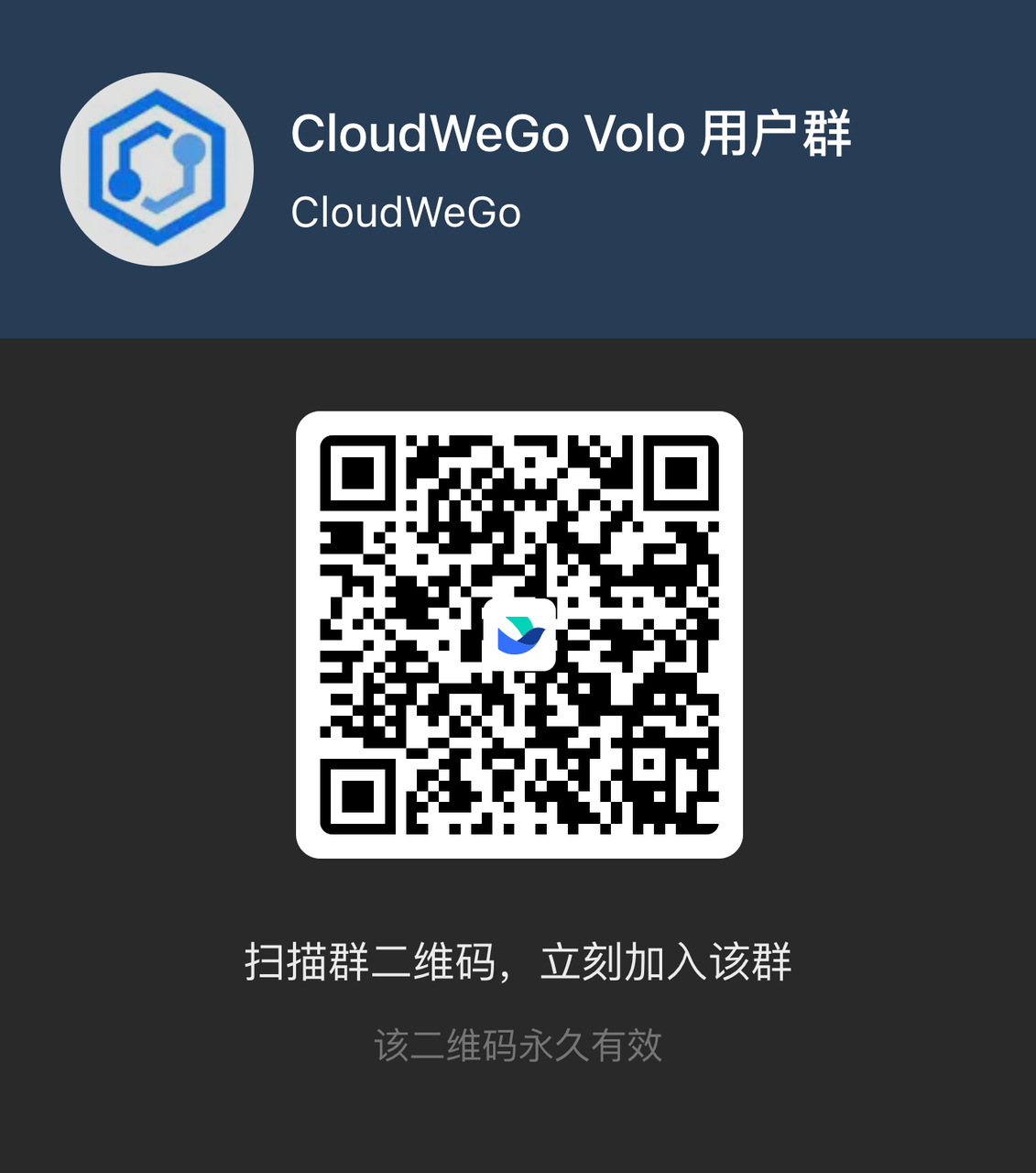快速开始
Part 1. 创建一个 Thrift Server
Volo-Thrift 是一个 RPC 框架,既然是 RPC,底层就需要两大功能:
- Serialization 序列化
- Transport 传输
IDL 全称是 Interface Definition Language,接口定义语言。
1.1 Why IDL
如果我们要进行 RPC,就需要知道对方的接口是什么,需要传什么参数,同时也需要知道返回值是什么样的,就好比两个人之间交流,需要保证在说的是同一个语言、同一件事。 这时候,就需要通过 IDL 来约定双方的协议,就像在写代码的时候需要调用某个函数,我们需要知道函数签名一样。
Thrift IDL 是一套跨语言的全栈式 RPC 解决方案,具体的语法可以看参考 thrift-missing-guide 或官方 Thrift interface description language。
1.2 编写 IDL
为了创建一个 Thrift 项目,我们需要先编写一个 Thrift IDL。
在你的工作目录下,我们先执行以下命令:
mkdir volo-example && cd volo-example
mkdir idl && touch idl/volo_example.thrift
随后,使用您喜欢的文本编辑器输入以下内容:
namespace rs volo.example
struct Item {
1: required i64 id,
2: required string title,
3: required string content,
10: optional map<string, string> extra,
}
struct GetItemRequest {
1: required i64 id,
}
struct GetItemResponse {
1: required Item item,
}
service ItemService {
GetItemResponse GetItem (1: GetItemRequest req),
}
保存退出后,我们执行以下命令:
volo init volo-example idl/volo_example.thrift
这里我们使用init命令,后面跟了我们项目的名字,意思是需要生成模板代码。在末尾,需要指定一个 IDL 表示 server 使用的 IDL。
如果只需要增加一个 IDL(如 client 的 IDL)而不需要生成模板的话,如:
volo idl add idl/volo_example.thrift
| 插播一个广告,volo 工具还支持从 git 下载 IDL 并生成代码哦,如:
volo idl add -g git@github.com:org/repo.git -r main /path/to/your/idl.thrift
| 感兴趣可以直接输入 volo 看详细用法~ 接下来回到正题~
这时候,我们整个目录的结构如下:
.
├── Cargo.toml
├── idl
│ └── volo_example.thrift
├── rust-toolchain.toml
├── src
│ ├── bin
│ │ └── server.rs
│ └── lib.rs
└── volo-gen
├── Cargo.toml
├── build.rs
├── src
│ └── lib.rs
└── volo.yml
然后,我们打开 src/lib.rs,在 impl 块中加入方法的实现,最终的代码应该是这样的:
pub struct S;
#[volo::async_trait]
impl volo_gen::volo::example::ItemService for S {
// 这部分是我们需要增加的代码
async fn get_item(
&self,
_req: volo_gen::volo::example::GetItemRequest,
) -> core::result::Result<volo_gen::volo::example::GetItemResponse, volo_thrift::AnyhowError>
{
Ok(Default::default())
}
}
然后执行:
cargo update && cargo build
这时候,就会发现 OUT_DIR 目录下多出来一个 volo_gen.rs 的文件了。
然后执行以下命令,即可把我们的 server 端跑起来:
cargo run --bin server
至此,我们已经能把我们的 server 跑起来啦!
Part 2. 编写 Client 端
上一节中,我们编写完成了 server 端,现在让我们来编写我们的 client 端并调用我们的 server 端。
首先,创建一个文件 src/bin/client.rs,输入以下内容:
use lazy_static::lazy_static;
use std::net::SocketAddr;
lazy_static! {
static ref CLIENT: volo_gen::volo::example::ItemServiceClient = {
let addr: SocketAddr = "[::1]:8080".parse().unwrap();
volo_gen::volo::example::ItemServiceClientBuilder::new("volo-example")
.address(addr)
.build()
};
}
#[volo::main]
async fn main() {
tracing_subscriber::fmt::init();
let req = volo_gen::volo::example::GetItemRequest { id: 1024 };
let resp = CLIENT.get_item(req).await;
match resp {
Ok(info) => tracing::info!("{:?}", info),
Err(e) => tracing::error!("{:?}", e),
}
}
然后,在 Cargo.toml 文件中加入所需的依赖,加入后的文件如下:
[package]
name = "volo_example"
version = "0.1.0"
edition.workspace = true
# See more keys and their definitions at https://doc.rust-lang.org/cargo/reference/manifest.html
[dependencies]
volo-gen = { path = "./volo-gen" }
volo.workspace = true
volo-thrift.workspace = true
pilota.workspace = true
anyhow.workspace = true
tokio = { workspace = true, features = ["full"] }
tracing-subscriber = "0.3.19"
lazy_static = "1.5.0"
tracing = "0.1.41"
[profile.release]
opt-level = 3
debug = true
debug-assertions = false
overflow-checks = false
lto = true
panic = 'unwind'
incremental = false
codegen-units = 1
rpath = false
[workspace]
members = ["volo-gen"]
resolver = "2"
[workspace.package]
edition = "2021"
[workspace.dependencies]
# we recommend to use the latest framework version for new features and bug fixes
volo = "*"
volo-build = "*"
volo-thrift = "*"
pilota = "*"
anyhow = "1"
tokio = "1"
接着,新建一个 terminal,执行以下命令,把我们的 server 端跑起来:
cargo run --bin server
最后,我们再回到当前目录,执行以下命令,即可看到执行成功:
cargo run --bin client
大功告成!
Part 3. 添加一个中间件
接下来,让我们来看下如何给 Volo 添加一个中间件。
例如,我们需要一个中间件,打印出我们收到的请求、返回的响应以及消耗的时间,那我们可以在 lib.rs 中写这么一个 Service:
#[derive(Clone)]
pub struct LogService<S>(S);
#[volo::service]
impl<Cx, Req, S> volo::Service<Cx, Req> for LogService<S>
where
Req: std::fmt::Debug + Send + 'static,
S: Send + 'static + volo::Service<Cx, Req> + Sync,
S::Response: std::fmt::Debug,
S::Error: std::fmt::Debug,
Cx: Send + 'static,
{
async fn call(&self, cx: &mut Cx, req: Req) -> Result<S::Response, S::Error> {
let now = std::time::Instant::now();
tracing::debug!("Received request {:?}", &req);
let resp = self.0.call(cx, req).await;
tracing::debug!("Sent response {:?}", &resp);
tracing::info!("Request took {}ms", now.elapsed().as_millis());
resp
}
}
随后,我们给这个 Service 包装一层 Layer:
pub struct LogLayer;
impl<S> volo::Layer<S> for LogLayer {
type Service = LogService<S>;
fn layer(self, inner: S) -> Self::Service {
LogService(inner)
}
}
最后,我们在 client 和 server 里面加一下这个 Layer:
use volo_example::LogLayer;
// client.rs
static ref CLIENT: volo_gen::volo::example::ItemServiceClient = {
let addr: SocketAddr = "[::1]:8080".parse().unwrap();
volo_gen::volo::example::ItemServiceClientBuilder::new("volo-example")
.layer_outer(LogLayer)
.address(addr)
.build()
};
// server.rs
volo_gen::volo::example::ItemServiceServer::new(S)
.layer_front(LogLayer)
.run(addr)
.await
.unwrap();
这时候,在 info 日志级别下,我们会打印出请求的耗时;在 debug 日志级别下,我们还会打出请求和响应的详细数据。
Part 4. What’s Next?
恭喜你,阅读到了这里! 至此,我们已经基本学会了 Volo 的大部分使用了,可以使用 Volo 来开启我们愉快的 Rust 之旅啦~
接下来,你可能需要选择合适的组件,组装在一起,和你的系统进行对接。
Volo 维护的相关生态会集中在:https://github.com/volo-rs 中,我们正在努力打造我们的生态,也非常欢迎大家一起参与~
如果有比较急缺的组件,也欢迎在官方仓库:https://github.com/cloudwego/volo 的 issue 中提出,我们也会优先支持社区最急缺的组件。
同时,欢迎加入我们的飞书用户群,交流 Volo 的使用心得~

期待你使用 Volo 创造出属于你的独一无二的作品~